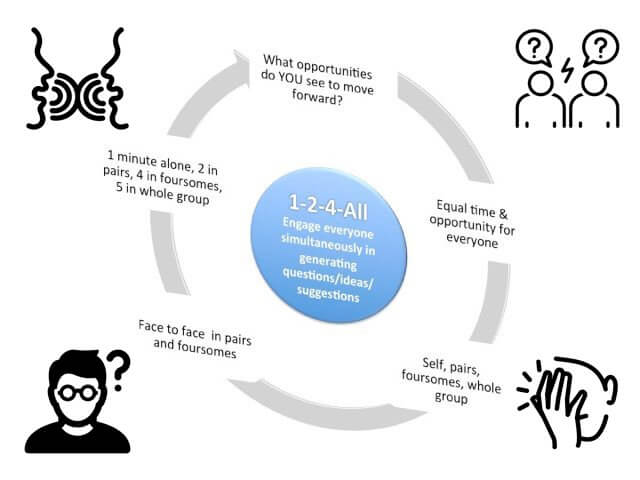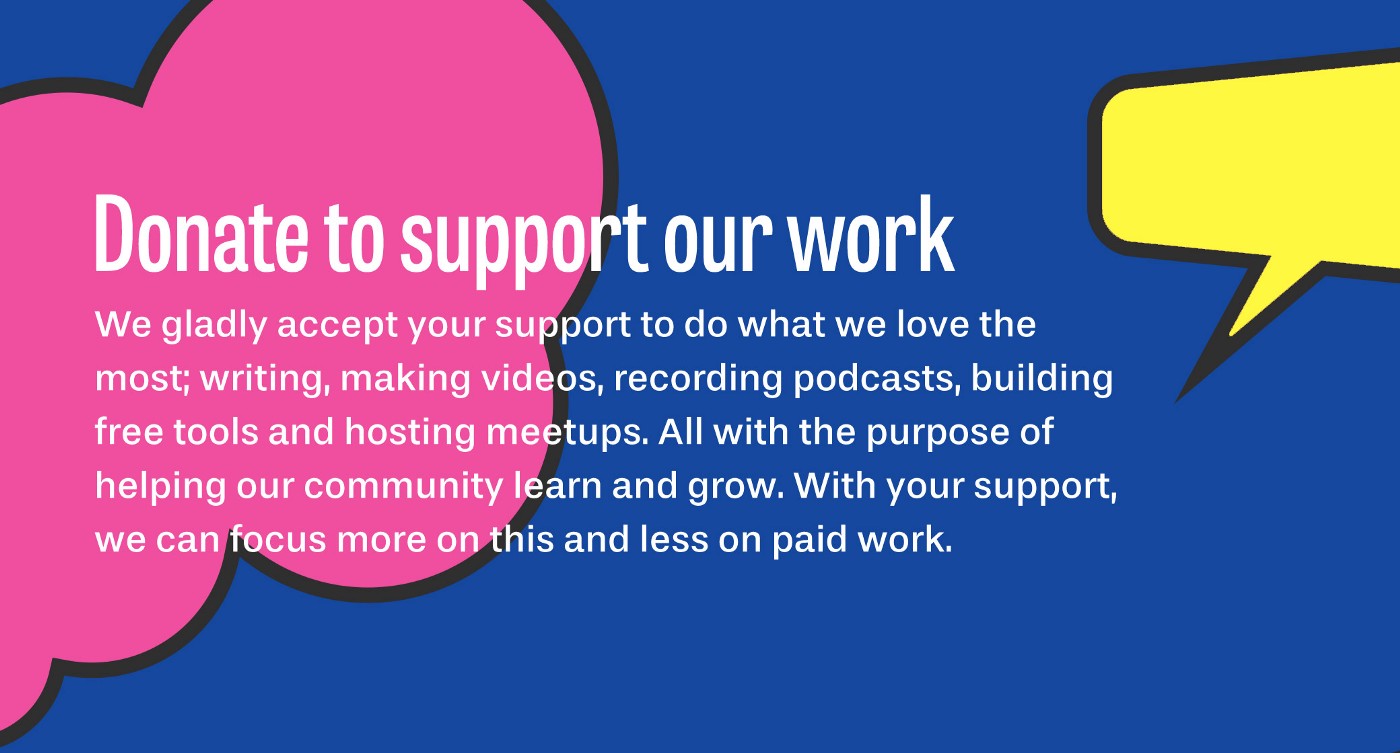Liberating Structures are 33 microstructures that allow you to unleash and involve everyone in a group – from extroverted to introverted and from leaders to followers. In this series of posts, we show how Liberating Structures can be used to spice up your Scrum events. Move away from the stickies and the whiteboards for a moment, and explore these novel facilitation techniques. If you’d like to experience Liberating Structures first-hand, make sure to join one the ‘immersion workshops’ that are taking place in March 2018.

1-2-4-All is one of the most applied facilitation techniques from the Liberating Structure collection. Within 12 minutes you can engage everyone simultaneously in generating questions, ideas, and suggestions. Regardless of how large the group is you’ll engage every individual in searching for answers. We’ve used this technique for our trainings with 12 participants, but also during seminars with 100+ people. It unfolds open conversations and sifts ideas and solutions in rapid fashion. Most importantly, participants own the ideas, so follow-up and implementation is simplified.
No buy-in strategies needed, simple and elegant!
In this post we'll explain the concept of silent self-reflection and share examples of how we've applied 1-2-4-All within our Scrum training and coaching engagements.
Silent Self-Reflection
One of the most powerful parts of 1-2-4-All is captured in the 1-minute of silent self-reflection. During this minute participants are invited to reflect on a shared challenge framed as a question, for example:
- What opportunities do you see for making progress on this challenge?
- How would you handle this situation?
- What ideas or actions do you recommend?
Taking time for silent self-reflection isn’t a very common practice in meetings or workshops. Often one or two persons are doing the talking and the rest is listening. Or smaller groups are working with each other and continuously talking. Which is fine. Yet before diving into a conversation about a certain challenge, taking some time for some silent self-reflection is very useful.
It gives you the opportunity to make up YOUR mind. What do YOU think? How would YOU deal with this situation?
Silent self-reflection should be done as a group, simultaneously. As a facilitator this is quite a challenge. People might consider the silence a bit awkward and start making noise or laughing nervously which distracts others. Therefore take sufficient time to explain the purpose and importance of the first part of 1-2-4-All. Done well, a comfortable silence is created in which the silent self-reflection will lead to the first ideas to deal with the challenge at hand!
Uses in Scrum and workshops
We’ve used 1-2-4-All for a number of applications in (and outside) Scrum:
- As part of a Scrum training to help define learning goals. Use the 1 minute of self-reflection to think of personal learning goals. Share your learning goals within pairs and afterwards a foursome. After 10 minutes the fully refined goals are discussed with the group as a whole.
- During the Daily Scrum. Most Scrum Teams use the Daily Scrum to share what they’ve done yesterday to help the Development Team meet the Sprint Goal. What they’ll do today and if they see any impediments that prevents achieving the Sprint Goal. Although using these questions is only a recommendation, most teams stick to it. I’ve worked with a Scrum Team that simply answered the question “what would be the best result we could achieve today?” By following the 1-2-4-All steps they defined a plan for the upcoming 24 hours.
- During a company-wide Retrospective with participants that used to be excessively influenced by their leader. With 1-2-4-All we ensured everyone was involved and all voices and opinions we’re heard and appreciated.
- As part of the Sprint Review to gather feedback on the Increment, adapt the Product Backlog, inspect likely completion dates and analyze marketplace changes and potential use of the product.
- During the Sprint Retrospective to inspect how the Sprint went with regards to people and relationships, to figure out how to make the next Sprint more enjoyable and to adapt the definition of “Done” to increase product quality.
- As an opening exercise of a large seminar. We invited over more than 250 people to reflect on the question “how is the Scrum Master a management position?”. After having everyone discussed the results in pairs and foursome, we discussed the main takeaways as a group. Within minutes the entire group was engaged and energized!
- To gather feedback (questions, comments, and ideas) after a presentation. Don’t ask the usual “any questions”, instead use 1-2-4-All to get more rich feedback.
- To redesign a boring weekly meeting with management.
- To address a problem or an innovation opportunity; 1-2-4-All offers a clear structure to discuss the challenge at hand.
Steps to use this Liberating Structure
- Start with 1 minute of silent self-reflection by individuals on a shared challenge, framed as a question;
- Take 2 minutes to generate ideas in pairs, building on ideas from self-reflection;
- Create groups of four and use 4 minutes to share and develop ideas that you’ve discussed within your pair. Notice similarities and differences.
- Take 5 minutes to share insights, ideas and takeaways by asking “What is one idea that stood out in your conversation?”. Each group shares one important idea. Repeat cycle as needed.
Picture from: http://www.liberatingstructures.com/1-1-2-4-all/
Stringing together with other Liberating Structures
A key characteristic of Liberating Structures is that they can easily combined to create programs for entire workshops or trainings. The options are endless:
- Start with Impromptu Networking to introduce a theme, facilitate a more in-depth reflection with 1-2-4-All;
- Use 1-2-4-ALL to discuss the questions in the final part of Appreciative Interviews
- Use the highest scoring ideas gather with 25/10 Crowd Sourcing as input for 1-2-4-ALL or Open Space Technology to translate actionable ideas into action plans;
Tips
- Facilitate the silent self-reflection firmly, before the paired conversations;
- Invite everyone to write down their ideas during the quiet self-reflection;
- Use Tingsha bells to announce transitions;
- Stick to precise timing, do another round if needed
- In large groups, during “All”, limit the number of shared ideas to 3 or 4;
- Invite each group to share unique insights;
- Make ideas visual; use your imagination;
- Maintain the rule of one conversation at a time in the whole group.
- Try this variation: go from groups of 4 to groups of 8 with consensus in mind.
Closing
In this article we’ve shared examples of how we've applied 1-2-4-All within our Scrum training and coaching engagements. We’re always happy to hear your experiences or hear your suggestions. If you’d like to know more about Liberating Structures or experience a large number of them first-hand, sign-up for one of the Liberating Structures ‘immersion workshops’ that are taking place throughout Europe in March 2018. Barry Overeem & Christiaan Verwijs are organizing the workshop in Amsterdam, which will be facilitated by co-inventor Keith McCandless and pioneer Fisher Qua.

